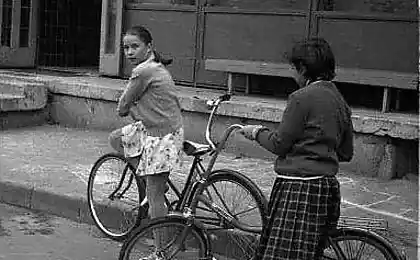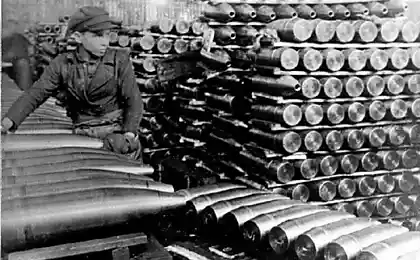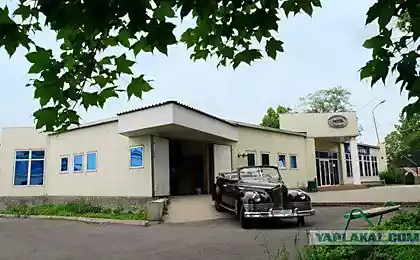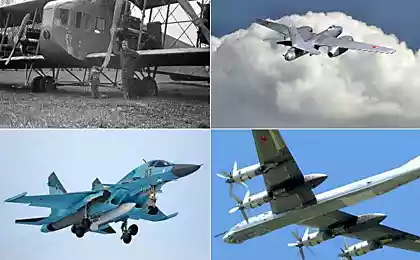934
Little-known Soviet aircraft
little-known Soviet aircraft
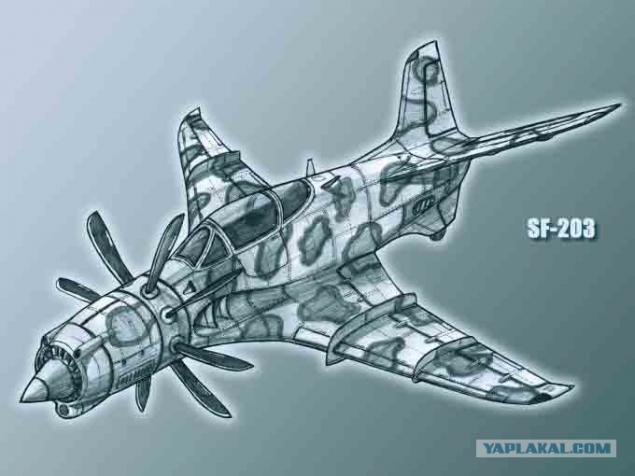
The works of Boris Ivanovich Cheranovskii
Aircraft Cheranovskii Boris Ivanovich (1896-1960) was a constant supporter of tailless layout scheme, tested them for the first time in gliders in the early 20s. A characteristic feature of the majority of its aircraft have been widely parabolic wing leading edge.
During the design of a new racing aircraft SG-1 (Beach 21), the designer and applied to him his favorite circuit, but the shape of the wing chose not parabolic, but close to it - trapezoidal with sloping front edge. It was the center-right, the console had a sweep of 25º and only wingtips outlines a gentle parabola. By type of front wing was a "reverse gull", at the bottom of breaks which were arranged fairings retractable landing gear. Because of the tailless aircraft scheme stood out among all its forms of competition vehicles. Usually stayed only cook with the hood of the motor rotor and side hatches approach to motor units.
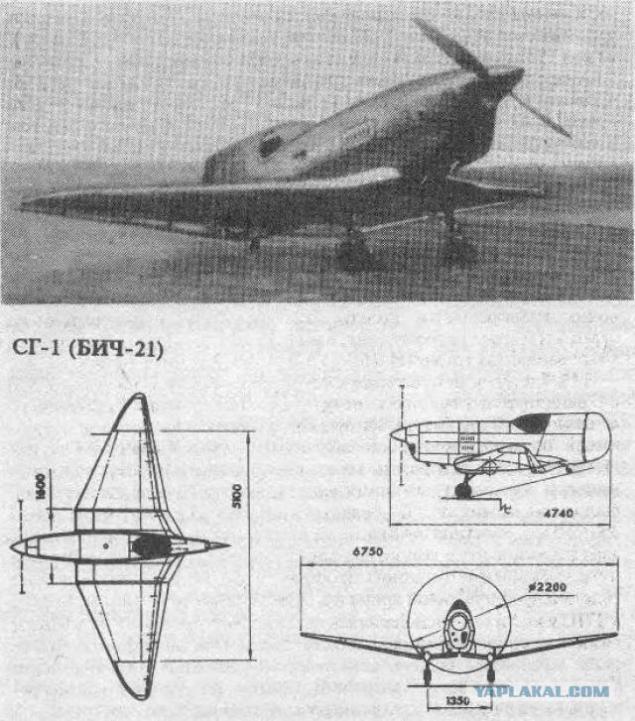
Very short fuselage had a length of a rudder does not exceed 4, 74 m. Teardrop canopy pilot with the fuselage with hexagonal cross-section in the area of the hood was extended back into a narrow stekatelya, rolling in a wedge-shaped vertical tail, takeoff weight SG-1 was the lowest of Compared to other racing cars - only 643 kg empty weight of 526. Due to this, and education under the wing of a dynamic air cushion in the air near the ground takeoff and landing performance turned out just outstanding. The effect of "screen" reduced landing speed of 80 km / h and run and run, respectively, 110 and 100 m. Counts with a souped-up engine CF-6A (240 hp) to reach 424 km / h.
Such unusually large numbers caused a critical attitude to the project of some aerodynamicists and designers. The plane had predicted a fiasco because the French "Caudron" considered inimitable perfection. But some experts have given positive reviews, among them - briginzhener VS Lush Mr. Engineer I rank AS Yakovlev.
How is it in reality? Due to the complexity of its naturally aspirated engine power, as in the series CF-6 was only 220hp, and flight tests achieved 417 km / h. But it is only 7 less than the calculated speed! SG-1 was the best of the finished by the summer of 1941
The works of Alexander Moskalev
Another participant. Small OKB Voronezh aircraft factory, led by Alexander Sergeyevich Moskalev, from the beginning it was not included. Later, the designers have created several light vehicles for various purposes with Renault engines. Among them, one of the world's first flying wing small triangular extension (0, 97) SAM-9 "Arrow", which became the prototype of modern supersonic aircraft tailless scheme. He CF-4 engine has a top speed of 340 km / h. Soedavalsya as a flying speed fighter model "Sigma" and therefore did not apply at the site of the race.
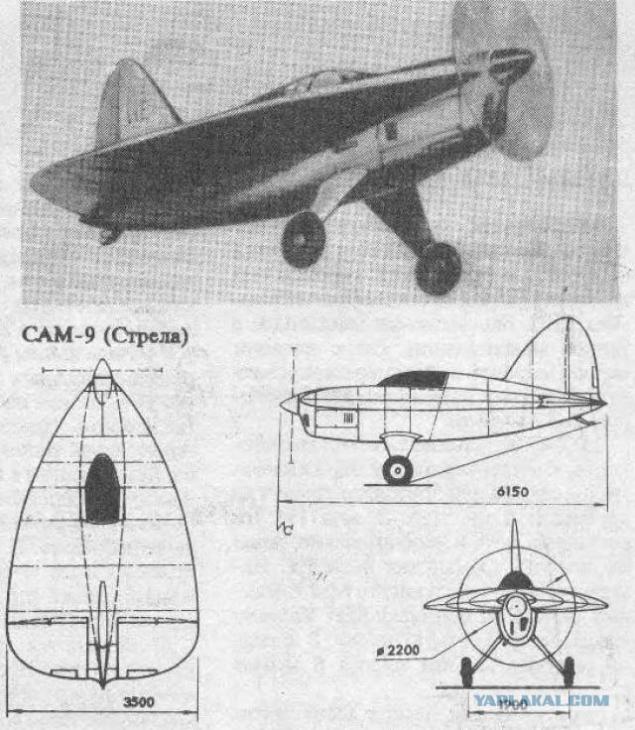
Meanwhile, even the five-seater (with pilot) CAM-10 passenger and modification of pre-production CAM-10bis could successfully compete in the speed with which appeared in those years, single-seater racing cars.
They have the same engines, but almost twice the take-off weight. CAM-10 monoplane developed a speed of 336 km / h. But he could fly faster. First we decided to do the chassis folding back under the wing, but completed his fixed gear and a wide closed fairing - "trousers". Development of a model - SAM-bis 10-2 has a retractable nose wheel and left on the stage of the project. Flight performance CAM-10 were higher than in the same "Simon" S.520 firm "Caudron". The aircraft with the same engine power and the number of seats a top speed of 300 km / h.
In 1939 1941 years. AS Moskalev engaged in the creation of the training and combat aircraft. Under the motor CF-6 fighter training laid CAM 12, It was developed in parallel with the machine VK Gribovskogo G-28 on the same task. Aerodynamic calculations he foretold a top speed of over 400 km / h. It was considered for a 220-horsepower engine excellent result. Again, the war is not allowed to release.
Design SAM-12 was mixed, with a predominance of wood. Main nogishassi retracted into the wing. It had a relatively small extension (4, 85) and articulated to the fuselage on nizkoplan scheme

Nose wheel placed underneath the engine, as it was envisaged in the draft CAM 10-2 bis. The aircraft differs utmost simplicity of lines, combining the correct aerodynamic shape.
Double version of SAM-12 was even more incomplete. Fighter Interceptor AS Moskalev, SAM-13, was arranged by dvuhbalochnon scheme tandem with the installation of two CF-6 engines at the ends of the short fuselage gondola, which were placed between the engines workplace pilot, fuel tank and equipment. The total capacity of the power plant was only 440 hp, so the design speed of the machine - 680 km / h exceeded the most optimistic assumptions.
To project the CAM-13 life manifested "reserved" attitude, but, despite this, the aircraft was built, was blowing in the tube T-101 TsAGI and on the eve of the war put to flight tests. Even with fixed landing gear fighter, piloted by ND Fiksonom showed the speed of 560 km / h. (Other designers have achieved a similar result by removing the chassis and engine capacity of over 1,000 hp)
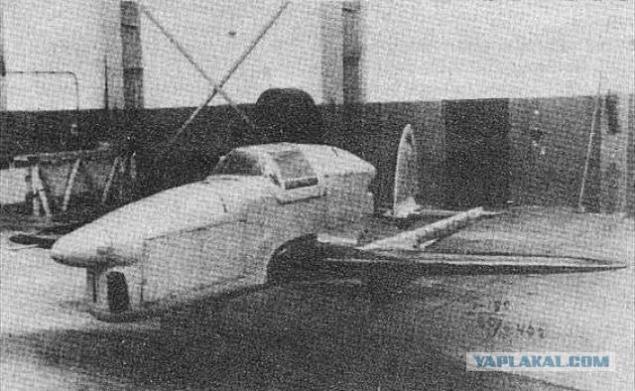
It is possible to have done more, but the complexity of the nose landing gear finishing, which moved up in the fuselage bad niche is not possible to obtain a treasured figure the maximum speed. Faktichsski achieved value was 607 km / h.
The fact that a significant aerodynamic superiority aircraft Moskalev on other machines with the same power capacity is obvious. To this day, the success of the constructor can not be explained, probably, like any talent.

Works Viktor Belyaev
In the 30 reptiles ways of increasing flight speeds become flatter. Many scientists have tried to then find effective ways to prevent the destruction of the machine in the air. The research was conducted in several directions. One of the most interesting solutions was not obvious at first glance stiffening wing and even closer to the center of mass of the structure of its center of stiffness and giving a new wing of a special form. It provided samosbalansirovannoe (against flutter) Status of the building at an ever increasing speed mode. Wing developed in TsAGI engineers VN Belyaev, and VI Yuharin. By type of plan it resembled stretched sideways letter "M", was extremely thin profile with a rather large extension and scope. It did not increase, but rather reduced rigidity in flight.
To check the calculations made by the so-called elastic wing designers, in addition to the made wind tunnel, built two special glider that by the summer of 1937 successfully passed flight tests and provided a valuable factual material necessary to produce this high-speed machines.
In 1938, a group of Viktor Belyaev (1896 - 1958) designed an experimental aircraft "UK" with elastic krshom his lean, named, like "Butterfly».
A successful solution to the layout of the aircraft low weight and small dimensions promoted the use of lightweight 12-cylinder engine Renault Ro.1 power up to 430 hp Slim M-shaped wing area of 11 m2 had a profile of variable thickness along the span - from 7, 5% to the root, to 5% at the end and is connected to the fuselage on the low-lying scheme.
Retractable landing gear wheels were placed in the bottom front part of the fuselage and the wing root configured for it with elliptical fairings. Cabins for two crew members, a pilot and the experimenter placed one after the other. Fuel tanks were placed in a wing of the areas swept consoles.
They hung deflected trailing edge flaps. Narrow two-section ailerons were at the end portions of the wing with a straight sweep. "UK" was calculated for all aerobatics, equipped with special devices, fixing a measure of stability and deformation of the wing at the various flight modes. Permissible fold overload construction reached 13.
Maximum design speed is 510 km / h in the takeoff weight of 1028 kg.
In developing the single version of the Criminal Code-1, intended for sports, the designers had hoped to establish a new speed record for landplanes. This would be possible by increasing the load on the wing, probably due to the decrease of its area. The official world speed record for land airplanes in November 1937 amounted to 611 km / h, and belonged to the German Messerschmitt Bf.113R *** with engine capacity of 1000 hp
Positive conclusion of the test the elasticity of the wing gliders eksperimentalnk VN Belyaev and promising project data "UK" Guide TsAGI led to the decision ... closing theme of light-speed machines. But quickly launched work on long-range bomber DB-LK, which had a similar wing, but much larger. It was built in 1939 and flight tests, which lasted until 1941, it showed a better performance than the serial DB-ZM with the same engines M-87B and bomb naruzke.
Despite the reorientation of designers TsAGI, headed by VN Belyaev, a heavy machine (this was a prerequisite established by the same designer: in 1935 he developed a project similar to the DB-LK passenger aircraft for Aviavnito competition, which took the second place after the project Romeyko- Gurko DA), the idea the creation of a single-engine high-speed aircraft with elastic wings have left. On the instructions of TsAGI EDO for light vehicles KAI (Kazan), led by 3. And Itskplicha (before that worked in the OKB-301 for the development of "Caudron" until 1939), and since 1940 - GN Vorobyov designed two similar apparatus: UK-1A with a resilient wing and UK-1B nizkoplan normal scheme. Both aircraft were double and differed only in the wing for the purity of comparative experiment, when all the other differences in the flight characteristics can be attributed to the difference la studied wings.
Because the engine Ro.1, laid back in the project Belyaeva, we have not caught on, KAI planes calculated under the single-row engine CF-6. Because of the smaller (twice) engine power maximum speed of both options it has not given reason to hope for the establishment of speed records. However, to participate in air races these devices well suited for that, in addition to the main goal - the experiment, the designers placed their hopes.
The first of the aircraft Kazan Aviation Institute with a resilient wing bylpostroen in 1940. In the spring of next year transferred to the customer at TsAGI for flight research. They did not take place.
The second remained unfinished because of the war. (Details of these devices have not been found.)
Works Matus Ruvimovich Bisnovatyi
Be sure to tell us about another project. In early 1938 it has developed a engineer Matus Ruvimovich Bisnovatyi (1905 - 1979), at that time an employee of OKB NN Polikarpov, and later chief engineer in the field of aeronautical engineering. The main emphasis was he doing at the maximum possible reduction in the drag of the aircraft by reducing its transverse dimensions and areas. In other words, increasing the total elongation of the apparatus. Characteristically complete lack of acting lantern cockpit. To improve the transparency of the review took sides of the fuselage at a fairly long distance - from the engine hood to the tail. In addition, the envisaged pilot hydraulic lift seats, providing a brief overview of the improvement in the take off and landing and at low speeds.
Achieving the maximum speed of 450 km / h (but calculated) required to increase the load on the wing to 130 kg / m2, which has resulted in the gross weight of 900 kg in the wing area, equal of 7 m2.
These figures are quite Mopti be implemented when the engine power of 220 liters. p., e.g., CF-6 engine, as well as retract. The project to bring the designer failed, but later turned to a similar aerodynamic configuration, Bisnovatyi built two high-speed fighter "IC" and "SK-2" preshedshie flight tests in 1940 - 1941. and showed very good results. With motor power of 1050 hp they developed a maximum speed of 660 km / h.
Works Sergey A. Kocherigina
Aircraft and projects design bureau Sergey A. Kocherigina usually designed for combat use (fighters, reconnaissance, attack). Project DIT aircraft had perhaps the most peaceful purposes among his fellow OKB. Its name means: two-seat fighter trainer. This device is not intended for real air combat.
The establishment of the training fighters have emerged after a visit to the Soviet technical delegation of the German aircraft factories, enterprises and institutions on the eve of the Second World War.
Among other facilities without interest turned out to be a German aircraft training aircraft company Arado Ar-96. The pilot performance this car appeared in 1936. It was equipped with a small engine "Argus" power of 150 hp and had two open booths for student pilot and instructor. In the period of intensified militarization of the German economy of small-nazkoplan Ar-96A company designers have breathed new life ... to install another engine "Argus" of As-410 to 465 hp, and it has meant for the training of military pilots. During the period from 1939 to 1945. Ar-96 was built in the series and has been repeatedly modified. It and its variants have received flight training school, many pilots of the Luftwaffe.
Following the example of the German firm Arado EDO SA Kocherigina located at the plant number 1, at the end of 1940 beginning of the research project on the same subject. For his Dita designers have chosen the type of engine Renault Ro1, which received the designation of CF-12 (the number of cylinders). Inverted circuit motor (cylinder head looking down) will remove from the earth the already tiny propeller (screw machine diameter 2 m 2) and apply a very compact and also retractable landing gear.
Wheels gear when cleaning fit into a niche between the front wall and the wing center box unit, which actually is an extension of up to 450 mm wing spar (for example biplane I-207 AA Borovkov and Florova IF).
The aircraft is configured for normal DIT nizkoplan circuit with double cabin crew. Flashlights pilots at the airport, in an emergency situation and in case of need the other had to move back on rails attached to the upper spars fuselage. Overall design and construction proved to be traditional. The composition of the board planned to introduce functional equipment RCI-3.
Armament consisted of a synchronous machine gun ShKAS odnoyu control and locking fotokinopulemeta. DIT project was signed December 12, 1940
As is known, motor Ro.1 (MV-12) factory number 26 to the reproduction was not adopted. Project implementation aircraft also did not get, but it is interesting for its development under the CF-12, what is seen as its compatibility with other devices discussed in this essay. (As of training fighters during the Second World War, the Air Force used adapted for this purpose, armed and unarmed modification of the Yak-7, La-5 and La-7).
All. Via
Source:

The works of Boris Ivanovich Cheranovskii
Aircraft Cheranovskii Boris Ivanovich (1896-1960) was a constant supporter of tailless layout scheme, tested them for the first time in gliders in the early 20s. A characteristic feature of the majority of its aircraft have been widely parabolic wing leading edge.
During the design of a new racing aircraft SG-1 (Beach 21), the designer and applied to him his favorite circuit, but the shape of the wing chose not parabolic, but close to it - trapezoidal with sloping front edge. It was the center-right, the console had a sweep of 25º and only wingtips outlines a gentle parabola. By type of front wing was a "reverse gull", at the bottom of breaks which were arranged fairings retractable landing gear. Because of the tailless aircraft scheme stood out among all its forms of competition vehicles. Usually stayed only cook with the hood of the motor rotor and side hatches approach to motor units.

Very short fuselage had a length of a rudder does not exceed 4, 74 m. Teardrop canopy pilot with the fuselage with hexagonal cross-section in the area of the hood was extended back into a narrow stekatelya, rolling in a wedge-shaped vertical tail, takeoff weight SG-1 was the lowest of Compared to other racing cars - only 643 kg empty weight of 526. Due to this, and education under the wing of a dynamic air cushion in the air near the ground takeoff and landing performance turned out just outstanding. The effect of "screen" reduced landing speed of 80 km / h and run and run, respectively, 110 and 100 m. Counts with a souped-up engine CF-6A (240 hp) to reach 424 km / h.
Such unusually large numbers caused a critical attitude to the project of some aerodynamicists and designers. The plane had predicted a fiasco because the French "Caudron" considered inimitable perfection. But some experts have given positive reviews, among them - briginzhener VS Lush Mr. Engineer I rank AS Yakovlev.
How is it in reality? Due to the complexity of its naturally aspirated engine power, as in the series CF-6 was only 220hp, and flight tests achieved 417 km / h. But it is only 7 less than the calculated speed! SG-1 was the best of the finished by the summer of 1941
The works of Alexander Moskalev
Another participant. Small OKB Voronezh aircraft factory, led by Alexander Sergeyevich Moskalev, from the beginning it was not included. Later, the designers have created several light vehicles for various purposes with Renault engines. Among them, one of the world's first flying wing small triangular extension (0, 97) SAM-9 "Arrow", which became the prototype of modern supersonic aircraft tailless scheme. He CF-4 engine has a top speed of 340 km / h. Soedavalsya as a flying speed fighter model "Sigma" and therefore did not apply at the site of the race.

Meanwhile, even the five-seater (with pilot) CAM-10 passenger and modification of pre-production CAM-10bis could successfully compete in the speed with which appeared in those years, single-seater racing cars.
They have the same engines, but almost twice the take-off weight. CAM-10 monoplane developed a speed of 336 km / h. But he could fly faster. First we decided to do the chassis folding back under the wing, but completed his fixed gear and a wide closed fairing - "trousers". Development of a model - SAM-bis 10-2 has a retractable nose wheel and left on the stage of the project. Flight performance CAM-10 were higher than in the same "Simon" S.520 firm "Caudron". The aircraft with the same engine power and the number of seats a top speed of 300 km / h.
In 1939 1941 years. AS Moskalev engaged in the creation of the training and combat aircraft. Under the motor CF-6 fighter training laid CAM 12, It was developed in parallel with the machine VK Gribovskogo G-28 on the same task. Aerodynamic calculations he foretold a top speed of over 400 km / h. It was considered for a 220-horsepower engine excellent result. Again, the war is not allowed to release.
Design SAM-12 was mixed, with a predominance of wood. Main nogishassi retracted into the wing. It had a relatively small extension (4, 85) and articulated to the fuselage on nizkoplan scheme

Nose wheel placed underneath the engine, as it was envisaged in the draft CAM 10-2 bis. The aircraft differs utmost simplicity of lines, combining the correct aerodynamic shape.
Double version of SAM-12 was even more incomplete. Fighter Interceptor AS Moskalev, SAM-13, was arranged by dvuhbalochnon scheme tandem with the installation of two CF-6 engines at the ends of the short fuselage gondola, which were placed between the engines workplace pilot, fuel tank and equipment. The total capacity of the power plant was only 440 hp, so the design speed of the machine - 680 km / h exceeded the most optimistic assumptions.
To project the CAM-13 life manifested "reserved" attitude, but, despite this, the aircraft was built, was blowing in the tube T-101 TsAGI and on the eve of the war put to flight tests. Even with fixed landing gear fighter, piloted by ND Fiksonom showed the speed of 560 km / h. (Other designers have achieved a similar result by removing the chassis and engine capacity of over 1,000 hp)

It is possible to have done more, but the complexity of the nose landing gear finishing, which moved up in the fuselage bad niche is not possible to obtain a treasured figure the maximum speed. Faktichsski achieved value was 607 km / h.
The fact that a significant aerodynamic superiority aircraft Moskalev on other machines with the same power capacity is obvious. To this day, the success of the constructor can not be explained, probably, like any talent.

Works Viktor Belyaev
In the 30 reptiles ways of increasing flight speeds become flatter. Many scientists have tried to then find effective ways to prevent the destruction of the machine in the air. The research was conducted in several directions. One of the most interesting solutions was not obvious at first glance stiffening wing and even closer to the center of mass of the structure of its center of stiffness and giving a new wing of a special form. It provided samosbalansirovannoe (against flutter) Status of the building at an ever increasing speed mode. Wing developed in TsAGI engineers VN Belyaev, and VI Yuharin. By type of plan it resembled stretched sideways letter "M", was extremely thin profile with a rather large extension and scope. It did not increase, but rather reduced rigidity in flight.
To check the calculations made by the so-called elastic wing designers, in addition to the made wind tunnel, built two special glider that by the summer of 1937 successfully passed flight tests and provided a valuable factual material necessary to produce this high-speed machines.
In 1938, a group of Viktor Belyaev (1896 - 1958) designed an experimental aircraft "UK" with elastic krshom his lean, named, like "Butterfly».
A successful solution to the layout of the aircraft low weight and small dimensions promoted the use of lightweight 12-cylinder engine Renault Ro.1 power up to 430 hp Slim M-shaped wing area of 11 m2 had a profile of variable thickness along the span - from 7, 5% to the root, to 5% at the end and is connected to the fuselage on the low-lying scheme.
Retractable landing gear wheels were placed in the bottom front part of the fuselage and the wing root configured for it with elliptical fairings. Cabins for two crew members, a pilot and the experimenter placed one after the other. Fuel tanks were placed in a wing of the areas swept consoles.
They hung deflected trailing edge flaps. Narrow two-section ailerons were at the end portions of the wing with a straight sweep. "UK" was calculated for all aerobatics, equipped with special devices, fixing a measure of stability and deformation of the wing at the various flight modes. Permissible fold overload construction reached 13.
Maximum design speed is 510 km / h in the takeoff weight of 1028 kg.
In developing the single version of the Criminal Code-1, intended for sports, the designers had hoped to establish a new speed record for landplanes. This would be possible by increasing the load on the wing, probably due to the decrease of its area. The official world speed record for land airplanes in November 1937 amounted to 611 km / h, and belonged to the German Messerschmitt Bf.113R *** with engine capacity of 1000 hp
Positive conclusion of the test the elasticity of the wing gliders eksperimentalnk VN Belyaev and promising project data "UK" Guide TsAGI led to the decision ... closing theme of light-speed machines. But quickly launched work on long-range bomber DB-LK, which had a similar wing, but much larger. It was built in 1939 and flight tests, which lasted until 1941, it showed a better performance than the serial DB-ZM with the same engines M-87B and bomb naruzke.
Despite the reorientation of designers TsAGI, headed by VN Belyaev, a heavy machine (this was a prerequisite established by the same designer: in 1935 he developed a project similar to the DB-LK passenger aircraft for Aviavnito competition, which took the second place after the project Romeyko- Gurko DA), the idea the creation of a single-engine high-speed aircraft with elastic wings have left. On the instructions of TsAGI EDO for light vehicles KAI (Kazan), led by 3. And Itskplicha (before that worked in the OKB-301 for the development of "Caudron" until 1939), and since 1940 - GN Vorobyov designed two similar apparatus: UK-1A with a resilient wing and UK-1B nizkoplan normal scheme. Both aircraft were double and differed only in the wing for the purity of comparative experiment, when all the other differences in the flight characteristics can be attributed to the difference la studied wings.
Because the engine Ro.1, laid back in the project Belyaeva, we have not caught on, KAI planes calculated under the single-row engine CF-6. Because of the smaller (twice) engine power maximum speed of both options it has not given reason to hope for the establishment of speed records. However, to participate in air races these devices well suited for that, in addition to the main goal - the experiment, the designers placed their hopes.
The first of the aircraft Kazan Aviation Institute with a resilient wing bylpostroen in 1940. In the spring of next year transferred to the customer at TsAGI for flight research. They did not take place.
The second remained unfinished because of the war. (Details of these devices have not been found.)
Works Matus Ruvimovich Bisnovatyi
Be sure to tell us about another project. In early 1938 it has developed a engineer Matus Ruvimovich Bisnovatyi (1905 - 1979), at that time an employee of OKB NN Polikarpov, and later chief engineer in the field of aeronautical engineering. The main emphasis was he doing at the maximum possible reduction in the drag of the aircraft by reducing its transverse dimensions and areas. In other words, increasing the total elongation of the apparatus. Characteristically complete lack of acting lantern cockpit. To improve the transparency of the review took sides of the fuselage at a fairly long distance - from the engine hood to the tail. In addition, the envisaged pilot hydraulic lift seats, providing a brief overview of the improvement in the take off and landing and at low speeds.
Achieving the maximum speed of 450 km / h (but calculated) required to increase the load on the wing to 130 kg / m2, which has resulted in the gross weight of 900 kg in the wing area, equal of 7 m2.
These figures are quite Mopti be implemented when the engine power of 220 liters. p., e.g., CF-6 engine, as well as retract. The project to bring the designer failed, but later turned to a similar aerodynamic configuration, Bisnovatyi built two high-speed fighter "IC" and "SK-2" preshedshie flight tests in 1940 - 1941. and showed very good results. With motor power of 1050 hp they developed a maximum speed of 660 km / h.
Works Sergey A. Kocherigina
Aircraft and projects design bureau Sergey A. Kocherigina usually designed for combat use (fighters, reconnaissance, attack). Project DIT aircraft had perhaps the most peaceful purposes among his fellow OKB. Its name means: two-seat fighter trainer. This device is not intended for real air combat.
The establishment of the training fighters have emerged after a visit to the Soviet technical delegation of the German aircraft factories, enterprises and institutions on the eve of the Second World War.
Among other facilities without interest turned out to be a German aircraft training aircraft company Arado Ar-96. The pilot performance this car appeared in 1936. It was equipped with a small engine "Argus" power of 150 hp and had two open booths for student pilot and instructor. In the period of intensified militarization of the German economy of small-nazkoplan Ar-96A company designers have breathed new life ... to install another engine "Argus" of As-410 to 465 hp, and it has meant for the training of military pilots. During the period from 1939 to 1945. Ar-96 was built in the series and has been repeatedly modified. It and its variants have received flight training school, many pilots of the Luftwaffe.
Following the example of the German firm Arado EDO SA Kocherigina located at the plant number 1, at the end of 1940 beginning of the research project on the same subject. For his Dita designers have chosen the type of engine Renault Ro1, which received the designation of CF-12 (the number of cylinders). Inverted circuit motor (cylinder head looking down) will remove from the earth the already tiny propeller (screw machine diameter 2 m 2) and apply a very compact and also retractable landing gear.
Wheels gear when cleaning fit into a niche between the front wall and the wing center box unit, which actually is an extension of up to 450 mm wing spar (for example biplane I-207 AA Borovkov and Florova IF).
The aircraft is configured for normal DIT nizkoplan circuit with double cabin crew. Flashlights pilots at the airport, in an emergency situation and in case of need the other had to move back on rails attached to the upper spars fuselage. Overall design and construction proved to be traditional. The composition of the board planned to introduce functional equipment RCI-3.
Armament consisted of a synchronous machine gun ShKAS odnoyu control and locking fotokinopulemeta. DIT project was signed December 12, 1940
As is known, motor Ro.1 (MV-12) factory number 26 to the reproduction was not adopted. Project implementation aircraft also did not get, but it is interesting for its development under the CF-12, what is seen as its compatibility with other devices discussed in this essay. (As of training fighters during the Second World War, the Air Force used adapted for this purpose, armed and unarmed modification of the Yak-7, La-5 and La-7).
All. Via
Source:
Imperial cruiser from Lego
This exhibit has been seen in the courtyard of one of the driving schools.

